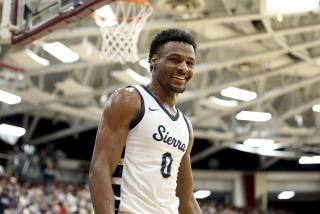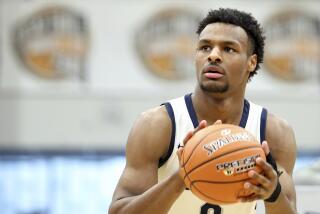They’re Taking Their Chances
- Share via
EL PASO — Will Kimble leaned forward, touching his chest just below his left shoulder.
“If you want to feel it, you can,” he said.
There, implanted beneath his skin but easily felt through his shirt, is a defibrillator, designed to shock his heart back into a normal rhythm if it detects an irregular heartbeat.
Because of a piece of technology smaller than a deck of cards -- and because Texas El Paso was willing to accept that there could be no absolute guarantee of his safety -- Kimble is a college basketball player again.
His worries are once again mundane, things such as the foot injury he has overcome and the playing time that has dwindled since he was a starter earlier in the season.
“I told him a foot was a light affliction, compared to a heart condition,” said his mother, Irene Donley-Kimble, a San Bernardino obstetrician. “We were cracking up about that.”
Kimble was a Pepperdine junior two seasons ago when he fainted during a November practice and was found to have a potentially fatal heart ailment known as hypertrophic cardiomyopathy.
“The doctor just flat-out said, ‘You’ll never play sports again,’ ” Kimble said. “I went through a period for a long time where I was lost. ‘What do I do now?’ I could have possibly gone downhill, dropped out, sunk into a hole.”
Now Kimble, a 6-foot-10 center, has become one of a growing number of athletes who have competed at high levels with defibrillators implanted in their chests.
Nicholas Knapp, a basketball player who unsuccessfully sued to be allowed to play at Northwestern in the late 1990s, went on to play two seasons at Ashland, a Division II program in Ohio.
Kayla Burt, a basketball player at Washington, resumed her career this season, two years after she’d fallen into a coma after her heart stopped while she was watching a movie with teammates.
“There is, of course, some sort of risk,” Kimble said. “I couldn’t tell you the exact percentage, but it’s a risk I’m comfortable with and my parents are comfortable with.
“If I felt like my life was at risk for this sport, I wouldn’t play,” he said.
Kimble, Burt and others like them are beneficiaries of technology that was still in its infancy in 1990, when Hank Gathers collapsed during a Loyola Marymount game and died.
Gathers, who was under treatment for a heart condition, did not have an implanted defibrillator. The first one implanted in a patient in Los Angeles was only five years earlier, in 1985. Until 1993, it required an open-chest procedure.
Now, the devices are so advanced that a patient can transmit data from a defibrillator through a phone line for a checkup.
Still, the memory of Gathers affects virtually every administrator who must decide whether to allow an athlete to play -- something even medical experts disagree on.
Kimble (who is not related to Bo Kimble, Gathers’ former Loyola teammate) was told no by administrators not only at Pepperdine, but also at UC Riverside and UCLA, even though David S. Cannom, director of cardiology at Good Samaritan Hospital and a clinical professor at UCLA, backed Kimble’s bid to play, the Kimble family said.
Decision makers must wrestle with conflicting information.
“It was a really tough call,” Pepperdine Coach Paul Westphal said. “I certainly had emotions, but I knew I did not have the expertise to make the call. I was glad I didn’t have to make it.”
Recommendations known as the Bethesda guidelines, from a 1994 conference sponsored by the American College of Cardiology, advise against allowing athletes with implanted defibrillators to participate in competitive sports.
A 2001 article in the Journal of Cardiovascular Electrophysiology agreed, saying that although defibrillators “have proven to be extremely effective for prevention of sudden cardiac death, their ability to terminate lethal arrhythmias under the conditions of vigorous physical activity associated with competitive athletics is unknown.”
Cannom, one of the authors of the 2001 article, now believes the guidelines should be liberalized.
“It’s become clear to me the recommendations have been overly restrictive,” he said, adding that a recent survey he conducted showed that 27% of more than 600 electrophysiologists had cleared patients to play basketball, including 15% who had cleared patients to play competitively.
“There are more and more young patients with [implantable defibrillators] who want to do more than simply play golf,” Cannom said.
Bruce Wilkoff, a cardiologist at the Cleveland Clinic, an expert on defibrillators and pacemakers, agreed that the risk was “very, very low.”
“You probably decide to drive,” he said. “Driving has some risks associated with it.”
Several cardiologists agreed that the risk of death from arrhythmia in a patient with an implanted defibrillator was considerably less than 1%, though there are concerns about the possibility of the connection from the device to the heart breaking because of contact or exertion. Cannom said routine monitoring could eliminate most risk.
Yet many universities and cardiologists say any level of risk is difficult to accept.
Pepperdine Athletic Director John Watson, who was at the West Coast Conference tournament game when Gathers collapsed, said he did not want Kimble to return to the court unless there was conclusive evidence he would be safe.
Charles Swerdlow, a cardiologist at Cedars-Sinai Medical Center and a clinical professor of medicine at UCLA, said there was a lack of data on athletes because they are such a small group.
“There aren’t good studies on exactly what it takes to break a defibrillator in a human body,” said Swerdlow, another expert who consulted on Kimble’s case. “Could it damage a defibrillator or the connections if you are hit in the chest with a baseball? If a professional athlete gave you a good elbow in the chest? If you fall on it? There aren’t any good studies.”
The decision is complicated by the mind-set of young athletes who have devoted tremendous work to their sports, perhaps planning to play professionally.
“They have little understanding of what it means to drop dead, and being dead is not in their scope of conceptualization,” Swerdlow said.
Donley-Kimble understands that from a physician’s standpoint, it is impossible to say there is zero risk.
“Yes, he is taking a risk,” she said. “We feel comfortable it is a small enough risk.”
Kimble remained at Pepperdine for two seasons, sitting on the bench and completing work toward his degree. He is in graduate school at Texas El Paso, playing as a senior in eligibility. The school, however, intends to petition the NCAA to get Kimble an additional year of eligibility from the NCAA because he sat out two seasons after his heart condition was discovered.
With clearance from Cannom, Kimble eventually resumed playing in a summer league. There, coaches from UC Riverside and UCLA saw him play and explored whether he could join their teams. Kimble thought he was so close to going to Riverside, he even had moved to an apartment in the area.
“It was another situation where the school didn’t want to be liable,” he said.
After UCLA passed, Bruin assistant Donny Daniels mentioned Kimble to Texas El Paso coaches.
UTEP accepted the risk, Kimble and his mother signing a liability waiver and agreeing to a monitoring program that includes checking his defibrillator after every game. He also wears a pad over the defibrillator when he plays, and an external defibrillator is kept nearby as well.
“To be honest, we talked to a lot of people,” UTEP Coach Doc Sadler said. “We never had one medical person question it, from his mother, to his first doctor, his personal and family doctor, our team doctor. Sure, it was something we had to get cleared all the way through [to university President Diana S. Natalicio]. If there was any hesitation at all, I’m sure Will wouldn’t be playing.”
It would be easy to look at the day Kimble fainted at Pepperdine as a dark day. Those close to him see it as a day that might have saved his life.
“We consider that he’s very, very blessed,” Donley-Kimble said.
More to Read
Go beyond the scoreboard
Get the latest on L.A.'s teams in the daily Sports Report newsletter.
You may occasionally receive promotional content from the Los Angeles Times.










